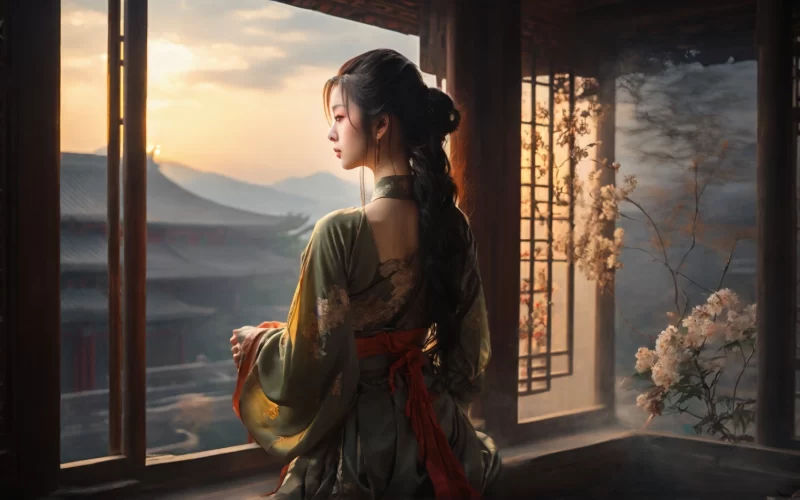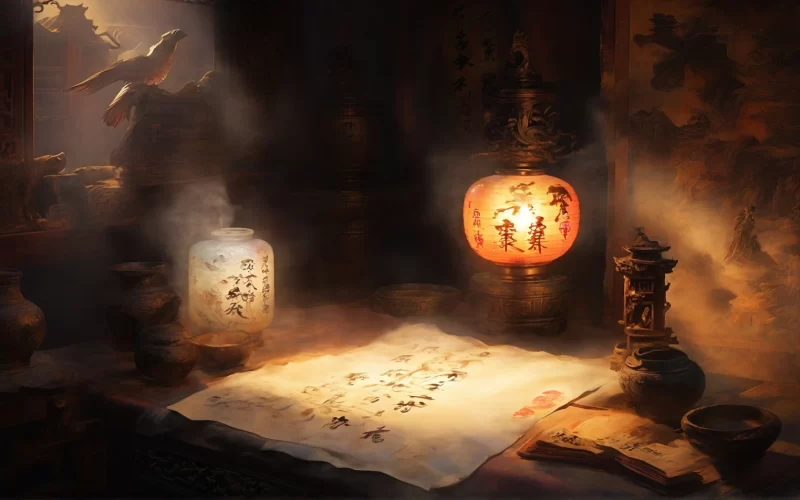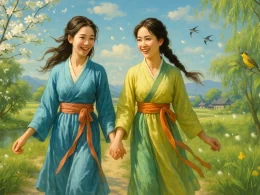Last night my girdle came undone, And this morning a luck-beetle flew over my bed. So here are my paints and here are my powders - And a welcome for my yoke again.
Original Poem
「玉台体」
权德舆
昨夜裙带解,今朝蟢子飞。
铅华不可弃,莫是藁砧归。
Interpretation
This quintessential boudoir poem takes its title "Jade Terrace Style" from Xu Ling's Southern Dynasties anthology "New Songs from the Jade Terrace," representing a poetic tradition focused on feminine emotions with delicate subtlety. Adopting a female perspective, it portrays lovesickness through domestic details, exhibiting tender restraint and emotionally rich expression.
First Couplet: "昨夜裙带解,今朝蟢子飞。"
Zuó yè qún dài jiě, jīn zhāo xǐ zǐ fēi.
"Last night my sash loosened without cause; This morning fortune spiders dance across."
The couplet employs two traditional auspicious omens—spontaneous sash loosening and spider sightings—to foreshadow reunion. The poet imbues mundane occurrences with symbolic romantic anticipation through objective correlatives.
Second Couplet: "铅华不可弃,莫是藁砧归。"
Qiān huá bù kě qì, mò shì gǎo zhēn guī.
"My face powder mustn't be neglected—Could my ax-handle man be expected?"
Encouraged by consecutive good signs, the protagonist hopes for her husband's return, reminding herself to maintain appearances. The emotional shift from surprise to eager anticipation reveals nuanced psychological transitions in waiting women.
Holistic Appreciation
Though brief, this exquisite poem microscopically captures traditional feminine psychology. Centering on "auspicious signs," it transforms ordinary nighttime sash loosening into romantic possibility, intensified by morning spider sightings. Through delicate domestic phenomena filtered by feminine sensitivity, the poet sketches a woman longing for reunion. The concluding rhetorical question "Could my man be returning?" conveys volumes of unspoken emotion, moving readers through implication rather than declaration.
Artistic Merits
This poem employs the traditional "expressing emotions through objects" technique characteristic of boudoir poetry. Through meticulous depiction of details like the "loosened sash" and "dancing spiders," it creates an exquisitely tender emotional atmosphere. Structurally, the opening line combines realistic description with symbolic meaning, the subsequent line transitions into psychological projection, and the concluding rhetorical question leaves artistic space that amplifies the emotional depth. With concise language and genuine sentiment, it vividly portrays a longing wife's hopeful anticipation and bashful tenderness, embodying the quintessential feminine grace in its most poetic form.
Insights
Through its delicate portrayal of daily life, this poem conveys an intricate interweaving of longing and hope, allowing us to perceive ancient women's steadfast devotion and patient waiting during their secluded years. In modern context, it reminds us to cherish those subtle yet moving signals in the emotional world, while revealing an enduring truth: the most sincere love often resides within the most ordinary daily details. The poem serves as a timeless testament to how profound emotions can be found in life's simplest moments, bridging centuries of human experience through its lyrical sensitivity.
Poem translator
Kiang Kanghu
Quan Deyu (权德舆) was a native of Tianshui, Gansu, 759-818 AD. At the age of four, he was able to write poems, and at the age of fifteen, he became famous and famous, and he did not stop writing books in his old age. His poems were mostly composed in response to the system of honoraria, but they were elegant and natural.












